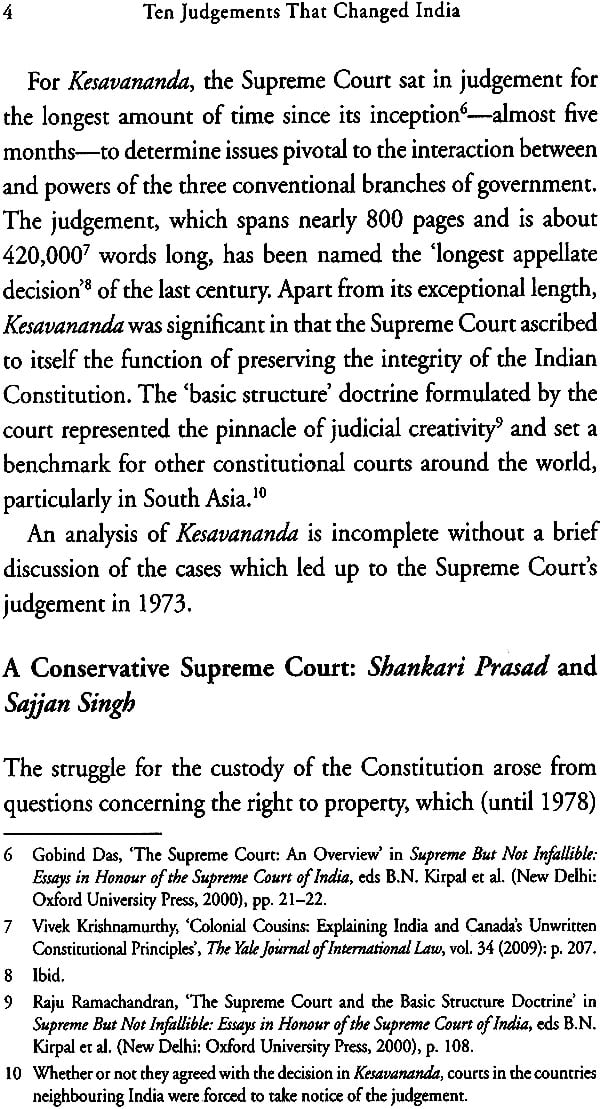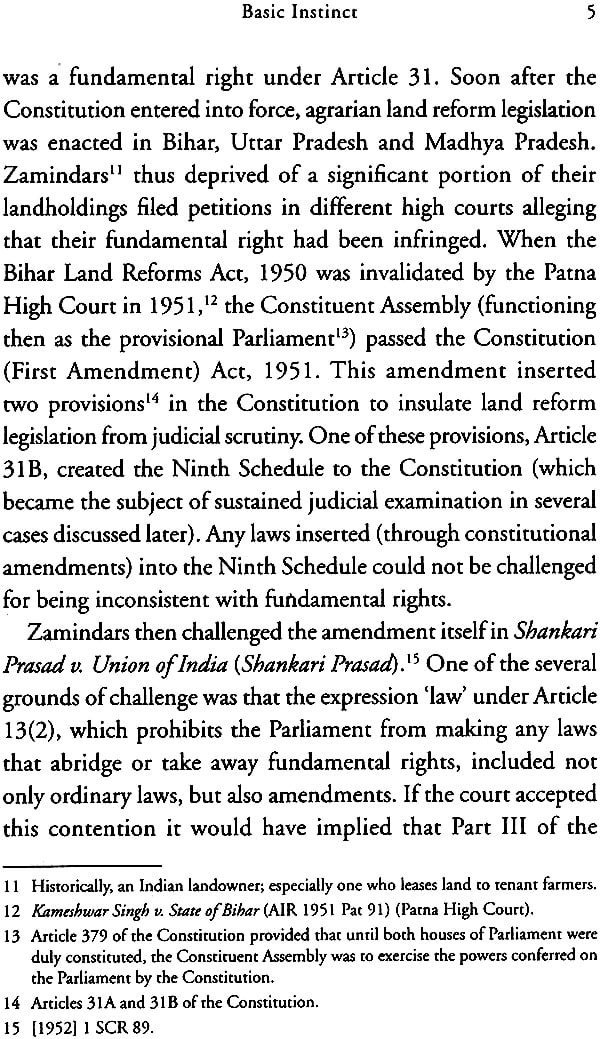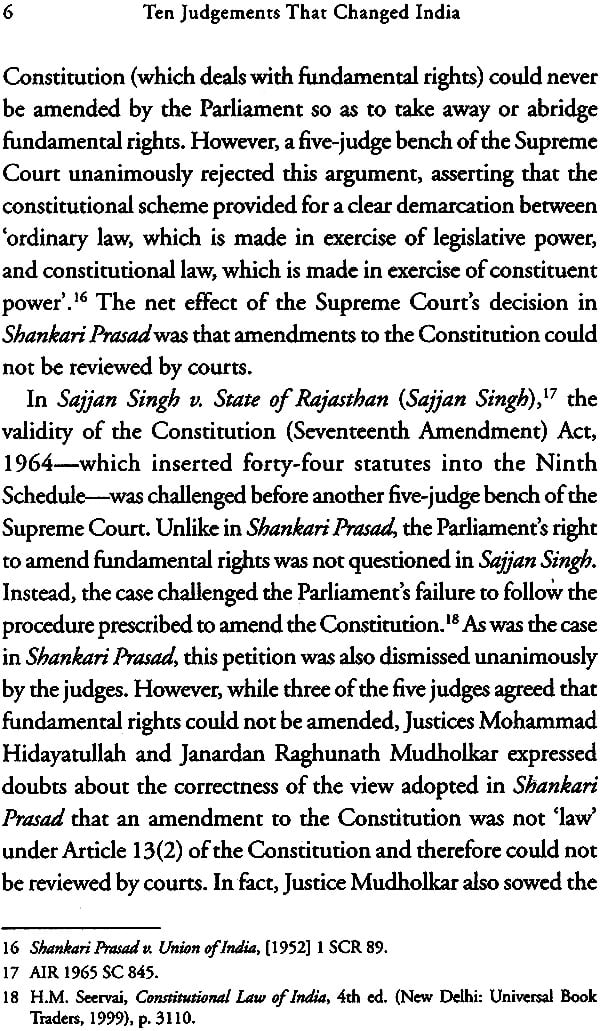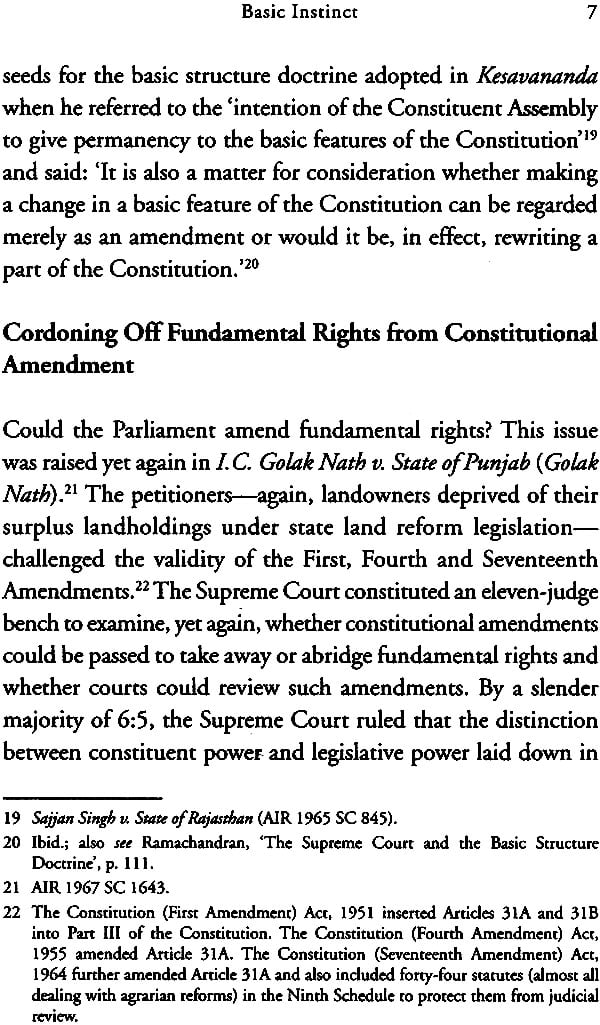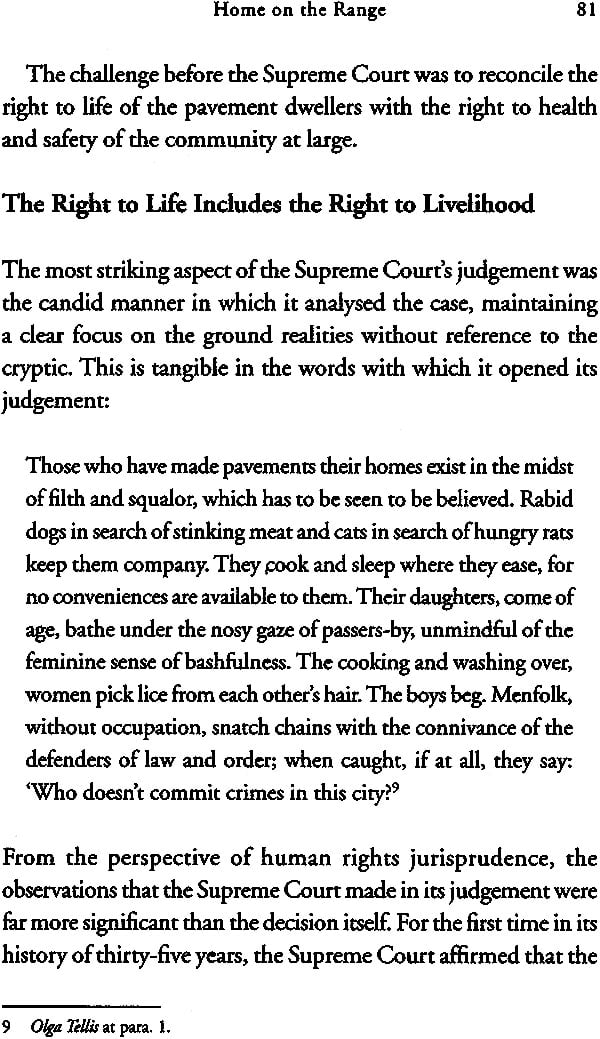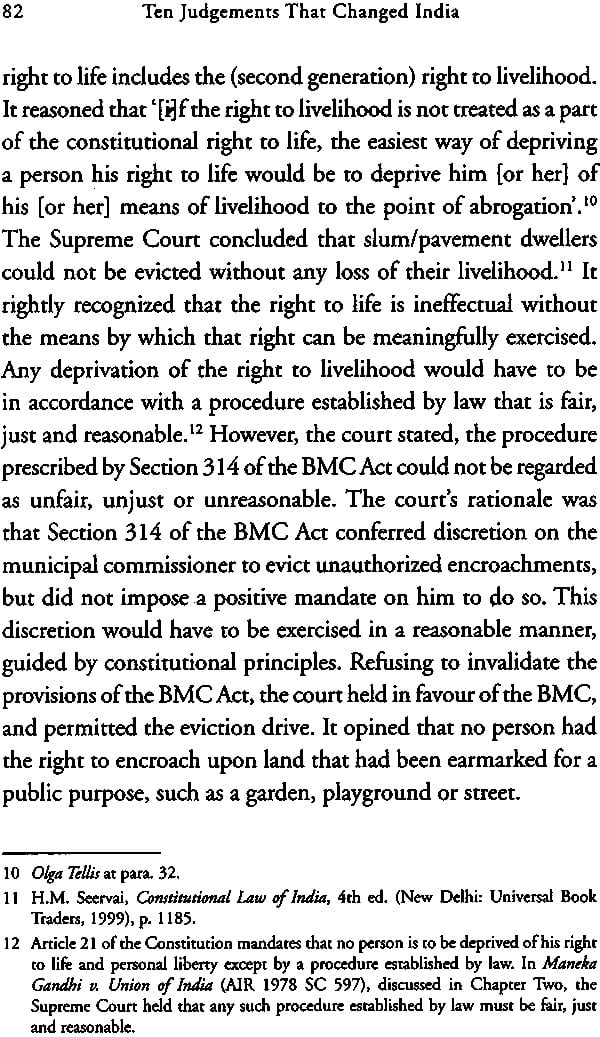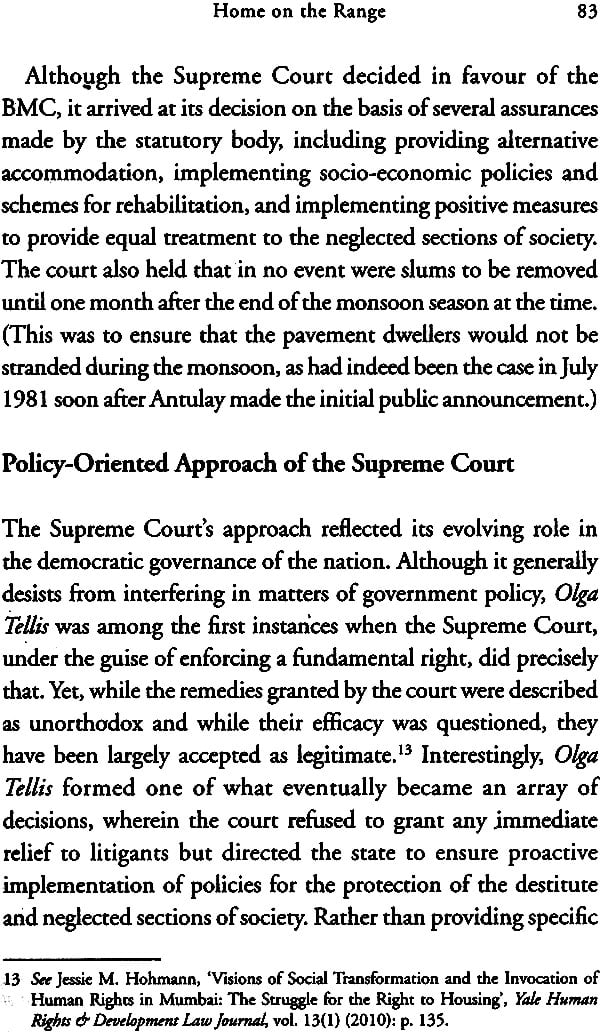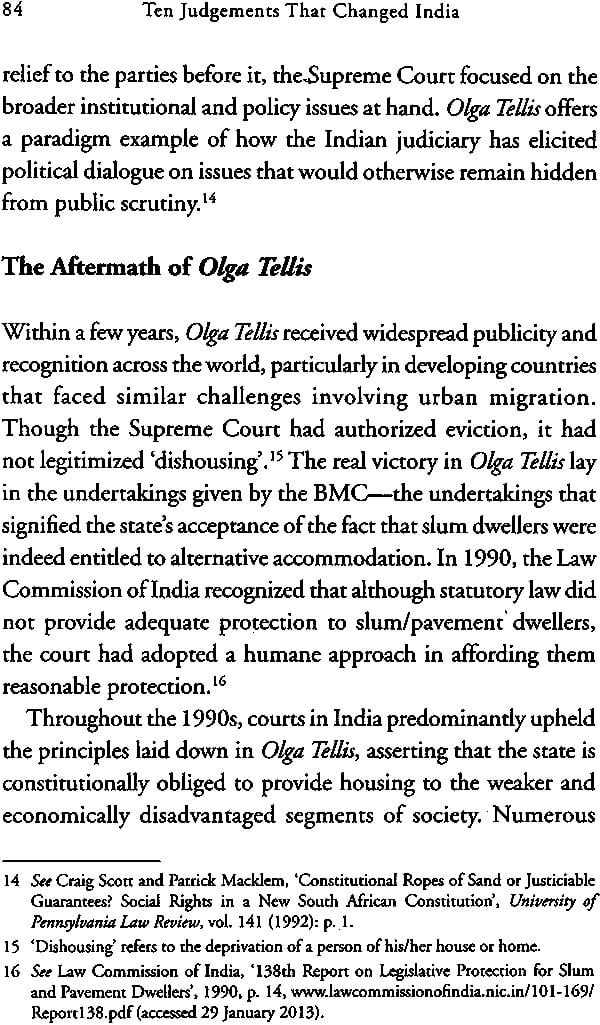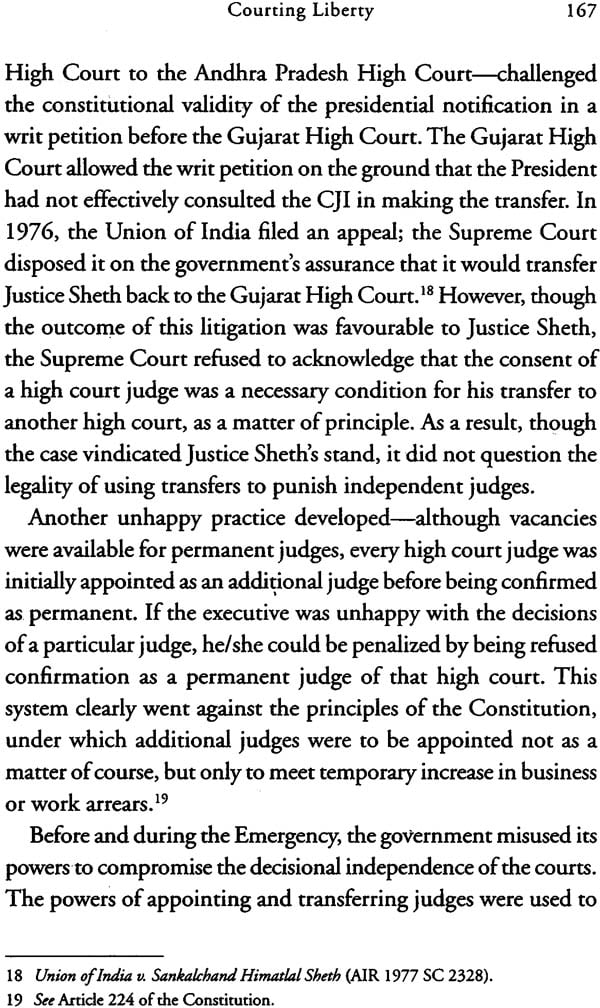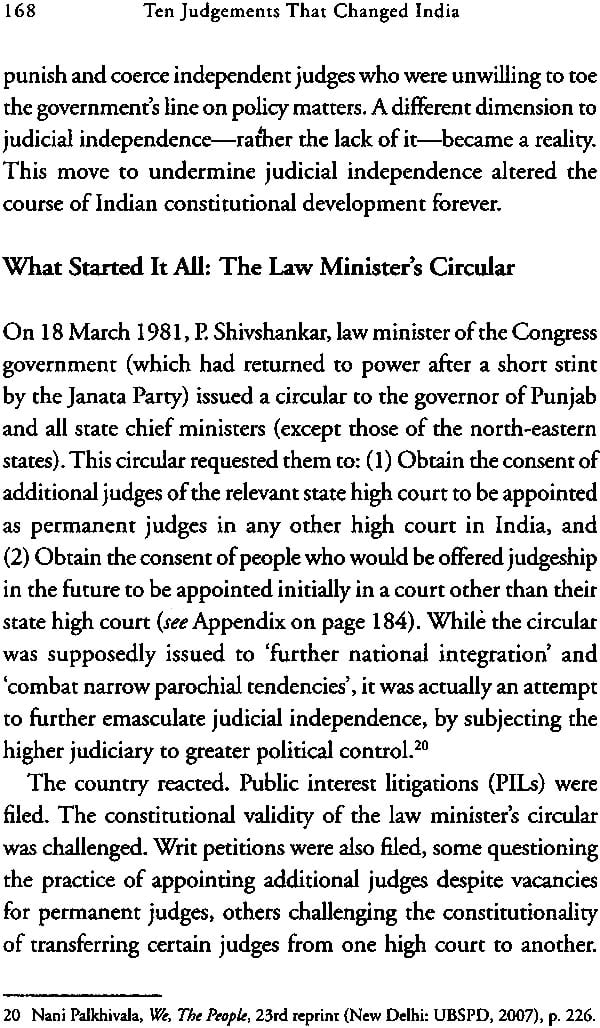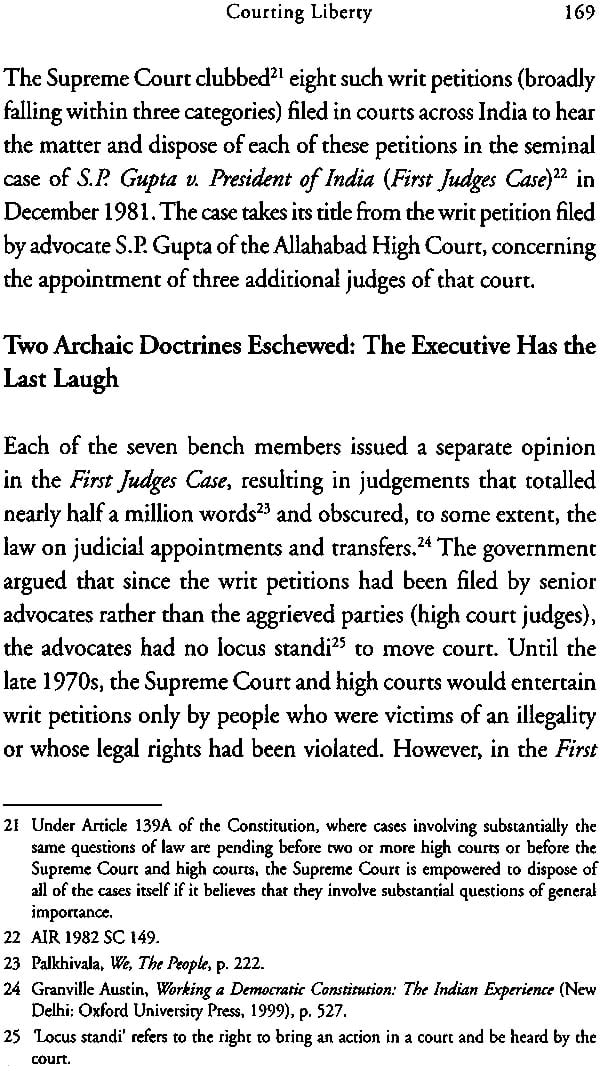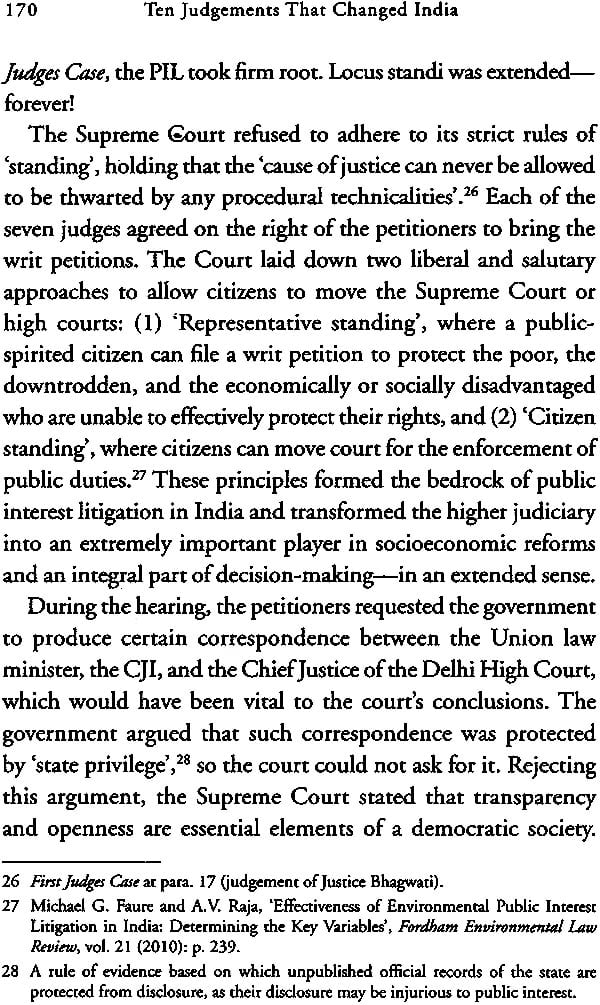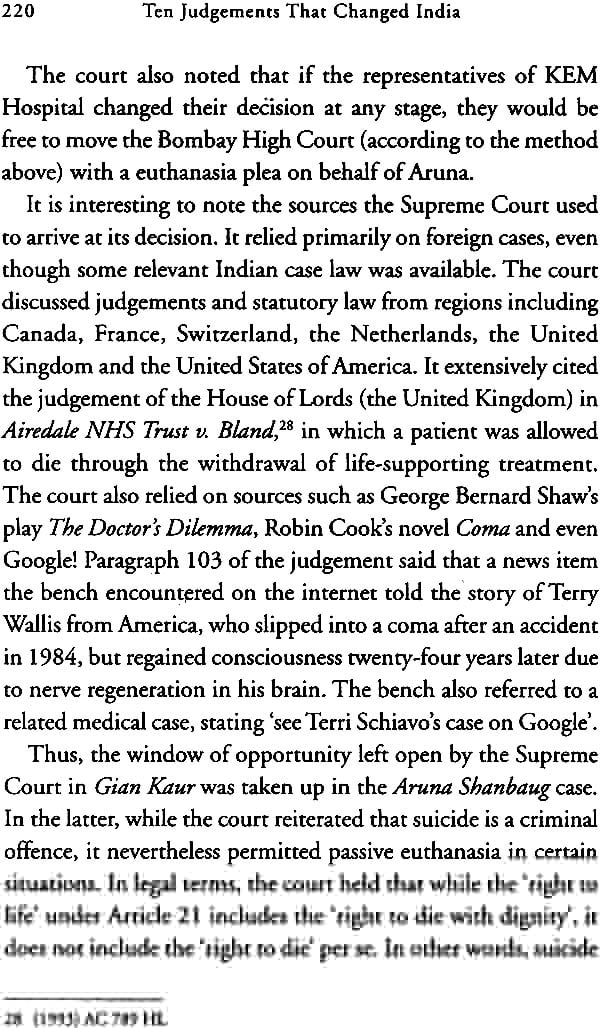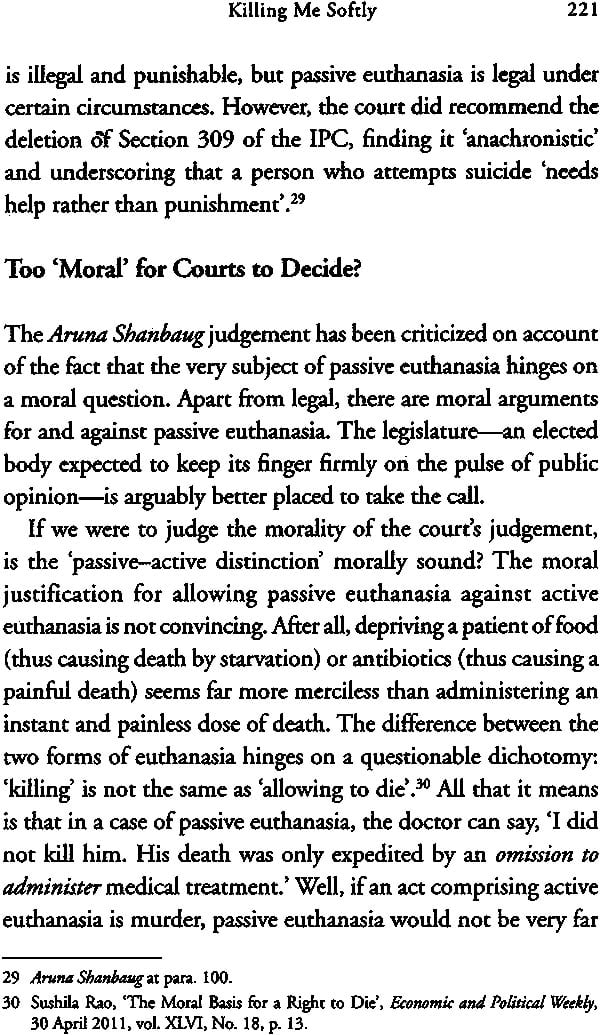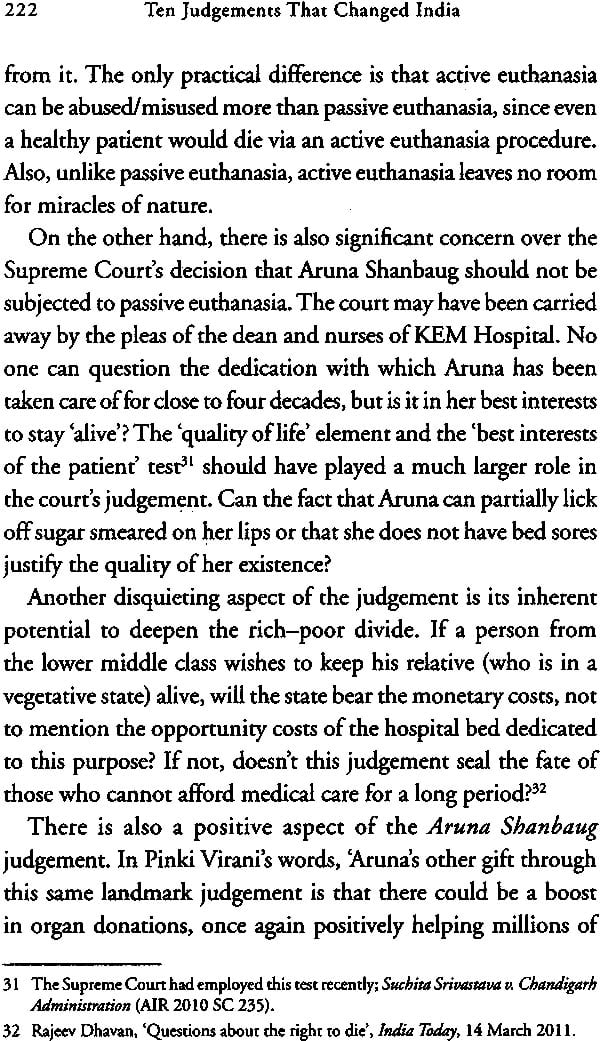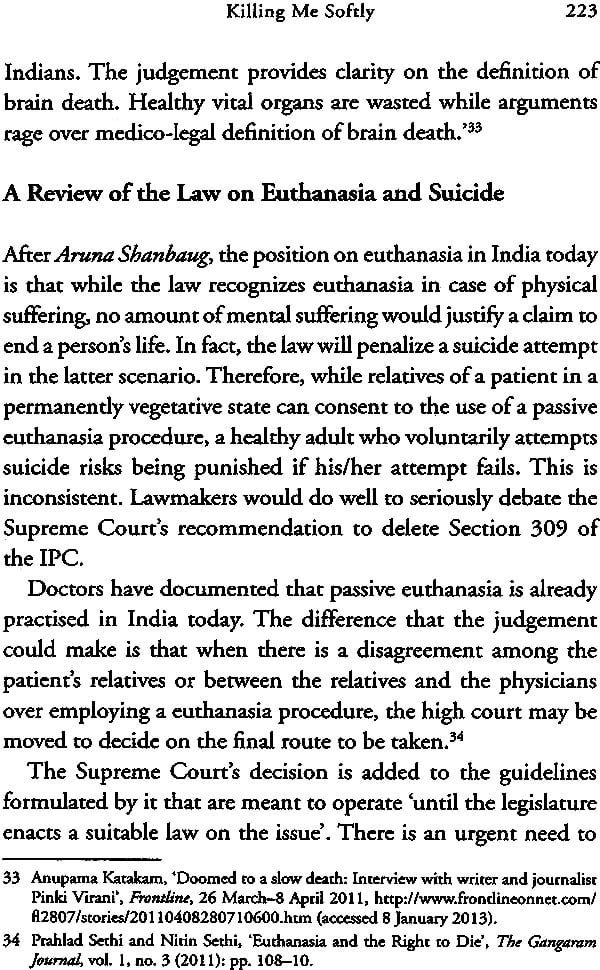
Judgement That Changed India
Book Specification
| Item Code: | NAG284 |
| Author: | Zia Mody |
| Publisher: | Penguin Books India Pvt. Ltd. |
| Language: | English |
| Edition: | 2013 |
| ISBN: | 9780670086627 |
| Pages: | 256 |
| Cover: | Hardcover |
| Other Details | 8.5 inch X 5.5 inch |
| Weight | 320 gm |
Book Description
,
Here are the Supreme Court's ten pivotal judgements that have transformed Indian democracy and redefined our daily lives. Exploring vital themes such as custodial deaths, reservations and environmental jurisprudence, this book contextualizes the judgements, explains key concepts and maps their impacts. Written by one of India's most respected lawyers, Ten Judgements That Changed India is an authoritative yet accessible read for anyone keen to understand India's legal system and the foundations of our democracy.
ZIA MODY is one of India's foremost corporate attorneys. She co-founded AZB & Partners, one of India's leading corporate law firms, and is senior partner at its Mumbai offices. Zia has been consistently ranked by renowned international business law journals as one of India's and Asia's best mergers and acquisitions lawyers, most powerful CEOs and commercial arbitration specialists. She was a vice president of the London Court of International Arbitration (2009-13) and is a director of the London Court of International Arbitration, India. She has also been a member of the World Bank Administrative Tribunal (2007 -12). She is on several government committees on financial reforms and corporate governance. Zia read law at University of Cambridge and Harvard Law School, and is a member of the New York State Bar. She is the daughter of legal luminary Soli J. Sorabjee. Zia is a committed member of her religion- the Baha'i Faith.
THE JUDICIARY, AT one time, was considered and projected to be the weakest branch of the state because it possessed neither power of the purse nor power of the sword. That myth has been demolished and the best evidence of it is the set of ten judgements analysed and discussed in this book. Many of the judgements that have been discussed were recognized, even at the time of their pronouncement, as path-breaking and having a profound impact on our nation. To find them being discussed several years later is indeed a testament to their continuing and pervasive relevance.
The Constitution, enacted in 1950, has been the cornerstone of India's democracy. After its enactment it has undergone several amendments. The Supreme Court is the ultimate interpreter of the Constitution and, by its creative and innovative interpretation, has been the protector of our constitutional rights and fundamental freedoms. The Supreme Court judgement in Kesavananda Bharati v. State of Kerala (AIR 1973 SC 1461) is unique in its impact. It evolved the doctrine of the 'basic structure' of the Constitution and ruled that even a constitutional amendment could be invalidated if it impaired the essential features-the basic structure-of the Constitution.
The book highlights instances of the manner in which the Supreme Court has performed its role and captures some of the more significant moments in its long and sometimes troubled history.
The judgements described in this book continue to have a real and resounding impact on society as a whole. These decisions are to be appreciated not only as precedents, but also as having laid down the law on issues of paramount importance-law that is binding on all courts and authorities in the country. In a maturing republic such as ours, the. common man must be made aware of and given an understanding of the workings of the law and the judicial process, which very often is seen as the exclusive domain of the legal profession. This book is a step in that direction. Rather than focusing just on the judgements of the court, the author has presented them in context, describing the surrounding cultural and social circumstances and the subsequent reactions of the public and the state to each case, coupled with a commendable legal analysis in language that is not legalese, but reader-friendly.
Zia Mody has made a captivating analysis which, I am sure, will be useful not just for members of the legal profession, but also for parliamentarians, law teachers, students and members of the public who are keen to know about our powerful Supreme Court and the impact of its judgements.
TO A LARGE and obvious extent, the title of this book shapes the prologue and the contents that follow. I believe that if there is one thing that most Indians still remain deeply proud of and have abiding faith in, it is their judiciary. One of the subliminal expectations of the common man is that justice will be delivered by the highest court of the land: the Supreme Court of India. To the intelligentsia, this is the forum in which both political and executive battles will be calibrated and decided. Many of us, especially practising professionals, take much pride in seeing how the Constitution of India has been infused with life, time after time, by a deft, adept, practical and inspired judiciary.
We take for granted, as a democracy, what many citizens in other countries over the world yearn for: the freedom of speech, access to justice, the right to vote and the right to practice one's religion. In this context, every young student of the law clearly comes to recognize both the independence and the importance of the Indian judiciary in our democratic polity.
Selecting ten judgements-those that can be termed 'landmark' cases-involved difficult decisions. The difficulty lay in deciding which judgements not to select simply because-as is evident when one starts looking at the subject-the seminal cases and landmark jurisprudence laid down by the highest court of the land have affected the basic liberties of millions of citizens throughout India. Many a time we tried to bring in other seminal judgements as part of the selection. For instance, A.D.M Jabalpur v. Shivkant Shukla (AIR 1976 SC 1207) has been discussed in the chapter on Maneka Gandhi v. Union of India (AIR 1978 SC 597) (Maneka Gandhi) (Chapter Two); S.P. Gupta v. President of India (AIR 1982 SC 149) has been discussed in the chapter analyzing Supreme Court Advocates-on- Record Association v. Union of India (AIR 1994 SC 268) (Chapter Eight); and Minerva Mills v. Union of India (AIR 1980 SC 1789) along with lR. Coelho v. State of Tamil Nadu (AIR 2007 SC 861) have both been analyzed in the chapter discussing Kesavananda Bharati v. State of Kerala (AIR 1973 SC 1461) (Chapter One).
As can be expected, to qualify as landmark decisions, most of these seminal judgements needed to have a distinct constitutional angle. It is interesting to see that from 1947 to 2011, in a short span of sixty-four years, our Constitution has been amended fairly extensively and interpreted fairly expansively. It is probably somewhat removed from what our founding fathers would have anticipated, but, by and large, something they would have been proud of, with the Supreme Court preserving its 'basic structure'.
Each of the ten judgements decided by the Supreme Court demonstrates the central role that the court plays in democratic governance in India. Some of these judgements have arisen as a result of both the pre- and post-Emergency Indira Gandhi regime. During this period, the court was in the throes of a constitutional conflict, torn between deciding on principles and sometimes, unfortunately, bowing to political exigencies. However, the guiding light that one hopes will continue is the ultimate thread of jurisprudence squarely in favour of a strong democracy armed with the unshakeable stamp, the freedom of speech, and the right to life with the other attendant basic constitutional safeguards.
The Emergency probably taught the Supreme Court of India many hard lessons, including, hopefully, some lessons it will never repeat. It also laid bare to the intelligentsia and the common man the fact that respite came from the gates of the courts.
Women dominate as the central figures in four of the ten selected judgements-seen in the cases of Maneka Gandhi, Mohammed Ahmed Khan v. Shah Bano Begum (AIR 1985 SC 945), Vishaka v. State of Rajasthan (AIR 1997 SC 3011) and Aruna Rama chandra Shanbaug v. Union of India ((2011) 1 SCALE 673). It not only reflects the tragedy of the Indian woman, but also the emergence of jurisprudence which seeks to set it right. Unfortunately, what remains is the practical reality of a long road yet to be travelled to unwind institutional and cultural discrimination against women.
Many of these cases have had an international impact and have been cited in different countries around the world, particularly in South Asia. The case of Olga Tellis v. Bombay Municipal Corporation (AIR 1986 SC 180), dealing with the rights of pavement dwellers, has arguably had a greater impact abroad than in India. As we are prone to do, many of the judgements run into hundreds of pages-but one would rather have prolixity (which leads to somewhat prolific and sometimes over-elaborate prose) than compromise on the quality of justice.
Current events in India-unfolding with Team Anna Hazare capturing the imagination of millions of people and the introduction of the Lokpal Bill (which seeks to constitute an independent anti-corruption ombudsman to curb widespread corruption in India) into Parliament-show how ingrained the DNA of democracy in the minds and hearts of Indian people is, especially of those comprising middle-class India. One would not be wrong in thinking that the Supreme Court's role is likely to be even more urgent, imperative, important and defining in the years to come.
| Foreword | xi | |
| Prologue | xiii | |
| One | Basic Instinct: A Landmark in Modern Constitutional Jurisprudence Kesavananda Bharati v. State ofKerala (1973) | 1 |
| Two | Life, Uninterrupted: The Supreme Court's Chance at Redemption Maneka Gandhi v. Union of India (1978) | 29 |
| Three | Whose Law Is It Anyway?: A Flashpoint in Religious Fundamentalism Mohammed Ahmed Khan v. Shah Bano Begum (1985) | 47 |
| Four | Home on the Range: The Emergence of 75 'Second Generation Rights' like Housing Olga Tellis v. Bombay Municipal Corporation (1985) | 75 |
| Five | Justice Delayed: The Loss through Law Union Carbide Corporation v. Union of India (1989 | 93 |
| Six | No, I Am More Backward Than You Are!': The Discourse on Reservations Indra Sawhney v. Union of India (1992) | 115 |
| Seven | Death in Custody: The Breach of Trust and Its Price Nilabati Behera v. State of Orissa (1993) | 135 |
| Eight | Courting Liberty: Independence of the Judiciary as Envisaged by the Constitution of India Supreme Court Advocates-on-Record Association v. Union of India (1993) | 161 |
| Nine | All in a Day's Work: Sexual Harassment at the Workplace Vishaka v. State of Rajasthan (1997) | 187 |
| Ten | Killing Me Softly: The Euthanasia Debate in India Aruna Ramachandra Shanbaug v. Union of India (2011) | 207 |
| Glossary | 239 |
